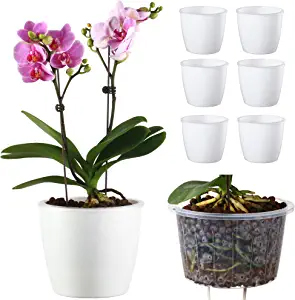How Do Self Watering Planter Pot Boxes Work?
As fascinating as it sounds, self-watering pots are not magical. They have a storehouse of water at the bottom. The plant keeps absorbing water from there to keep the soil moist and hydrated at all times.
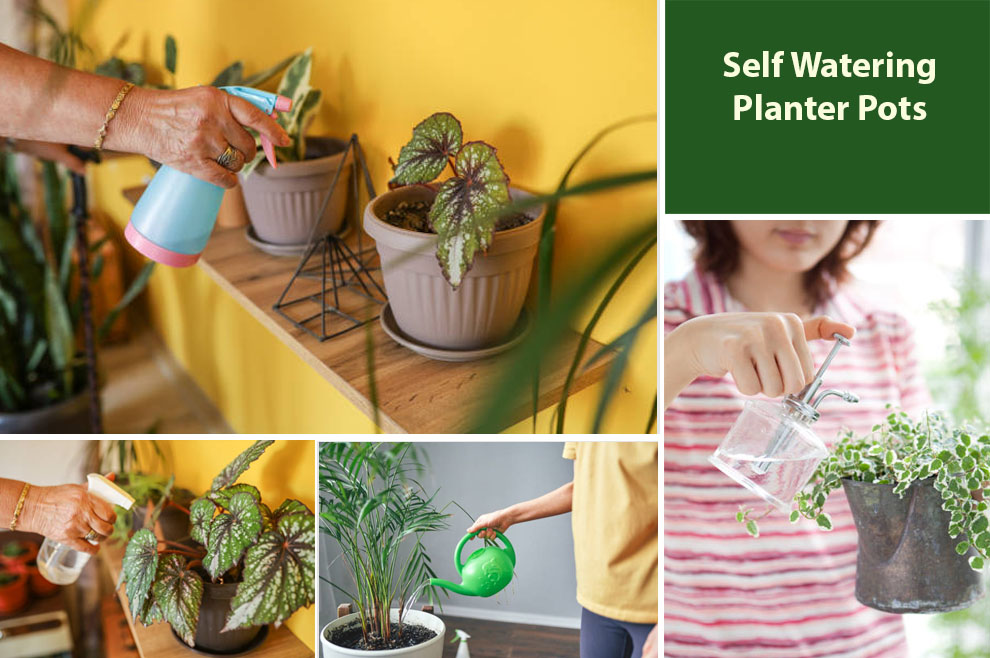
Underwatering or overwatering are the two primary woes associated with houseplants. It might result in the plant’s droopy appearance, curling leaves, and yellow spots. In all honesty, it might be challenging to assess your plant’s watering requirement at any given time.
It is where the self-watering or sub-irrigated pots come into play. These planters are water-efficient, convenient, and help you grow healthy plants. If you are as intrigued by how do self watering pots work as we are, then let’s solve this puzzle together.
In simple words, these planters have water stored at the bottom. This water is absorbed by the plants via the roots as and when needed in the required amount.
From DIY pots to fancy, high-end planters, you can find a plethora of self-watering containers & pots in various styles and budgets. The options are endless, and if you do not want to buy a planter, you can even consider making your planter at home for cheap.
Self-watering planters have an appealing functionality. They self-hydrate the plant. So, you can toss your watering schedule out of the window. It eases stress and helps you grow healthy and attractive plants. But they have their share of pros and cons. Here, we will discuss it all and see whether these planters work.
How Does A Self-Watering Planter Box Work?
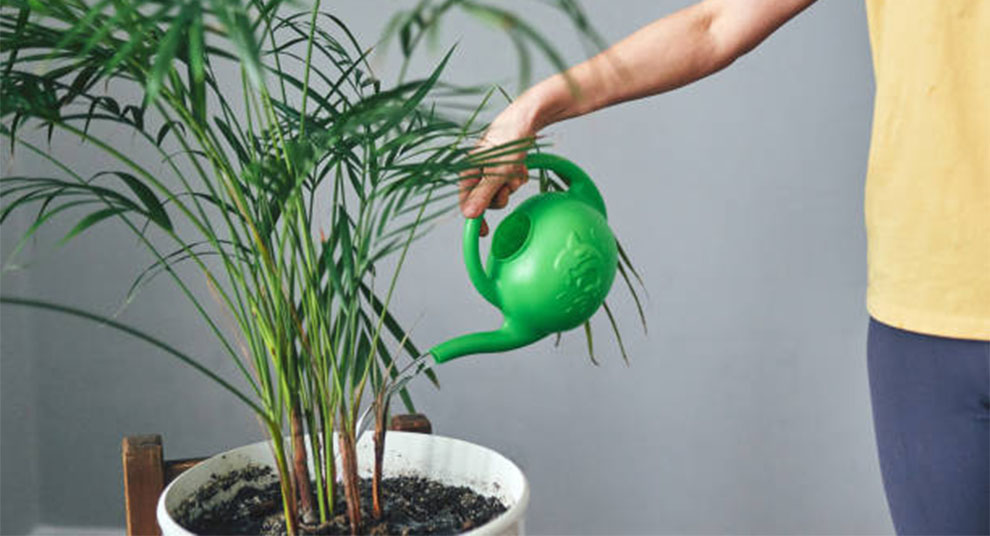
Usually, people water their plants from the top even when they absorb the water from the base. On the contrary, the self-watering planters will have reservoirs located at the pot’s bottom, making it easier for the plant to draw the water as required via the capillary action.
It is primarily the root system that extracts the water from the reservoir and takes it upwards because of the adhesion, cohesion, and surface tension. After the water reaches the plant’s leaves, it commences photosynthesis and other vital plant processes.
If the plant gets more water than it needs, the excess water accumulates at the pot’s bottom, which tends to oversaturate the roots.
Consequently, the capillary action becomes challenging, justifying why overwatering is the number one cause of plant death and root rot. However, since self-watering pots keep water separate from the plant, they will not drown the roots.
If the plant does not get adequate water, the water it receives stays on top of the soil. It parches the roots underneath. But, if you refill your planter periodically, you do not have to worry about over or underwatering.
How Do You Fill A Self Watering Planter?
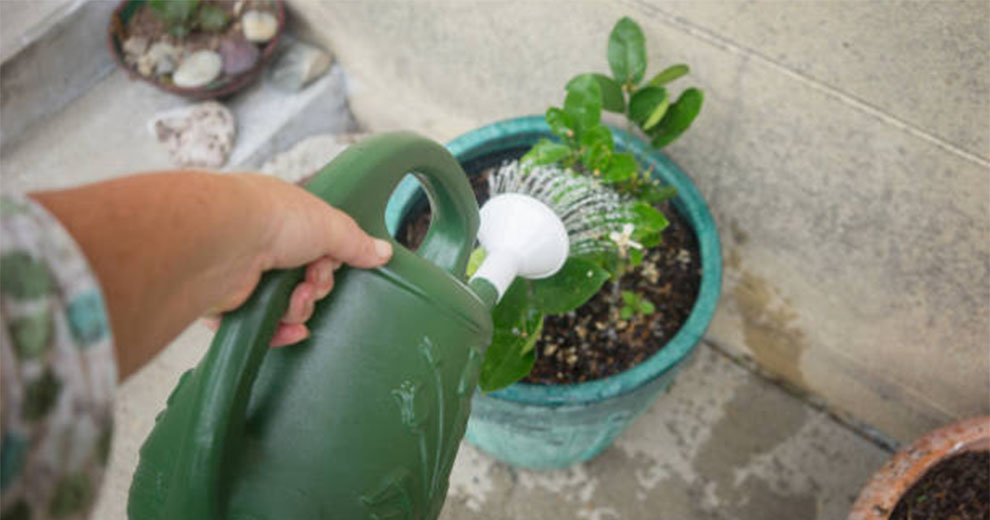
You now understand how do self watering pots work. Hence, you know for them to work as needed, you must manually refill them routinely because self-watering containers are not annexed to a drip or a sprinkler system.
Typically, these pots will have an indicator that notifies when the planter requires more water. Next, use the tube exposed in a position where a water jug can be used or above the soil for adding water into the reservoir.
You can also use this opportunity to add nutrients to the soil. However, if the planter has access to rainwater, ensure there are drainage holes too. It helps avoid overwatering.
Here are the steps for filling the self-watering planter:
- To avoid condensation, ensure that the planter is either at level or elevated above the area it is nestled.
- Add a non-biodegradable filter if the container is larger than the space necessary for the plant to grow.
- Use a landscape fabric as a wall between the soil and filler. It also ensures that the excess water from the over-saturated soil eliminates from the roots.
- Add six inches of soil suited for the plant.
- Next, tamp down and add more soil.
- Repeat the same process.
- Now add the sipper, plant, and soil.
- Water the soil.
- Ensure there is approximately an inch gap between the planter’s top and the soil’s top.
Are Self Watering Planters Successful and Really Work?
If used correctly, the self-watering planters can give you a healthy plant growth. So, instead or buying watering cans, you should opt for a self-watering pot.
Best Self-Watering Pots to Buy
We have elaborated on how do self watering plant pots work. So, if you wish to grab one for your plants, here are some of the top recommendations:
1. 8″ Self-Watering + Self Aerating High Drainage Deep Reservoir Round Plant Pot, Maintains Healthy Roots, for Indoor & Outdoor & Windowsill Gardens
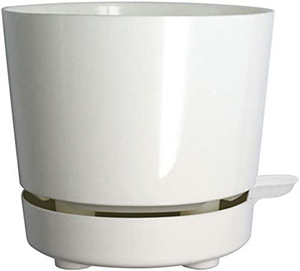 |
Check price on Amazon |
2. Self watering Planter, FENGZHITAO Clear Plastic Automatic-Watering Planter Flower Pot Square-Plant-Pot for All Plants, Succulents, Herb, African Violets, Flower
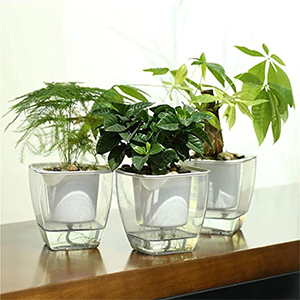 |
Check price on Amazon |
3. Vanavazon 6 Inch Self Watering Planter Pots for Indoor Plants, 3 Pack African Violet Pots with Wick Rope-Grey
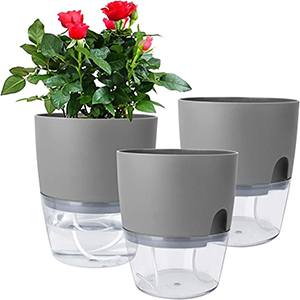 |
Check price on Amazon |
Problems With Self Watering Pots
You know how do self watering planters work, but before you put them into practice, you must be aware of some of the problems associated with them. These include:
1. They do not work for all plants.
Self watering plants do no work for plants that thrive in well-drained or dry soil, like succulents and cacti. Succulents work well in a desert environment. So, the continuous moisture fed to them via the soil increases the risk of over-watering and eventually dying.
They need the soil to dry before the next watering session, but self watering plants work the opposite by keeping the moisture consistent at all times.
2. It can become a breeding ground for mosquitoes.
One of the most prevalent concerns with self watering planters is the water in the reservoir often becomes the hotbed for mosquitoes. Since it is still water, mosquitoes lay eggs that hatch within twenty-eight hours. The soggy conditions make it easier for them to multiply.
The situation can be even more alarming for people residing in countries with warm and humid conditions. Hence, to ensure that these planters do not become a breeding nests, you must regularly flush the water out every few days.
After filling in the reservoir with water, cover the access holes with a tiny fly screen mesh. Instead, you may also hunt for pot designs wherein the access water is sealed.
3. You cannot use them for large plants.
Self watering pots do not work well for large plants with a sophisticated and long root system. The same holds for standard pots, but this problem is graver in self-watering planters because the plant’s roots travel to the reservoir’s pure water. It puts the plant at risk of root rot, fungal diseases, and death.
4. They make the soil susceptible to gnats and fungus.
Excess soil moisture, which the self-watering pots offer, makes the soil susceptible to fungus gnats and algae. Algae compete with the plant for water and nutrients and intervene in the plants’ growth.
In addition, they also release spores, which can be harmful, especially for young plants. So, if you are growing tiny plants, keep a check on your pot, ensuring there are no fungi and gnats.
5. They are costlier than regular containers.
Naturally, these are pricier than the standard pots because of the extra functionality they offer. Typically, the price depends on the style and size you choose.
Hence, investing in the self-watering planters can dig a hole in your pocket, especially if you hope to swap all your current pots for self-watering ones.
6. You cannot set and forget them.
Lastly, a prevalent misconception surrounding these pots is that you can fill in the water and leave them aside. However, it is far from the truth. Please be cautious, study your plant’s watering requirements, and ensure that you offer it the right conditions and soil. Hence, you cannot leave and forget about them.
Advantages of Self Watering Planters
We have discussed how do self watering planters work and their negatives, but there are also many pros to using them. These include:
1. They provide a flexible growing space
Today most people live in apartments. Hence, gardening is curtailed to the windows, patios, terraces, and balconies. Self-watering containers are ideal as you can place them anywhere, regardless of your garden’s shape and size.
2. They save water
We continually hear about global warming. So, in this scenario, it is essential that you consciously take steps to save water – the elixir of life. Self watering planters can be your blessing as they lower the water waste from evaporation and seepage.
3. They help keep the roots moisturized
In self watering pots, the water gets stored in its outer chamber. Hence, it only reaches the roots as and when required. Thus, they will ensure that the plants develop healthily and do not have stunted growth.
4. The nutrients remain preserved in the soil
Overwatering might result in soil losing its precious nutrients. But, the self-watering containers are enclosed. Hence, the nutrients do not get washed away so easily. Instead, they get preserved in the soil, unlike in the traditional container.
5. It prevents weeds
Plastic mulch enveloping the soil surface does not let the weeds grow. Moreover, since the water is balanced, weeds remain at bay.
6. It lowers the chances of diseases
Self-watering plants employ capillary activity to add moisture to the soil. The pots directly water the soil. Thus, the stems and the leaves do not come in contact with water. It helps keep molds and powdery mildew at bay.
7. It ensures a consistent water supply
With these intelligent containers, the plants can access the water as and when needed. Thus, they do not suffer from extreme moisture fluctuations, which may happen otherwise.
What Is The Best Self Watering Potting Mix?
Pick the correct potting mix to ensure your self-watering planter works well. We recommend shopping for commercial potting soils formulated exquisitely for these planters. You can also make your own potting mix with equal parts good-quality compost, perlite, coconut coir, and peat moss but buying a store bought dedicated mix is better.
So, to begin with these hi-tech pots, it’s important to first know how do self watering pots work and secondly get the right soil mix that goes well with the planter.
Do You Put Rocks In The Bottom Of A Self Watering Planter?
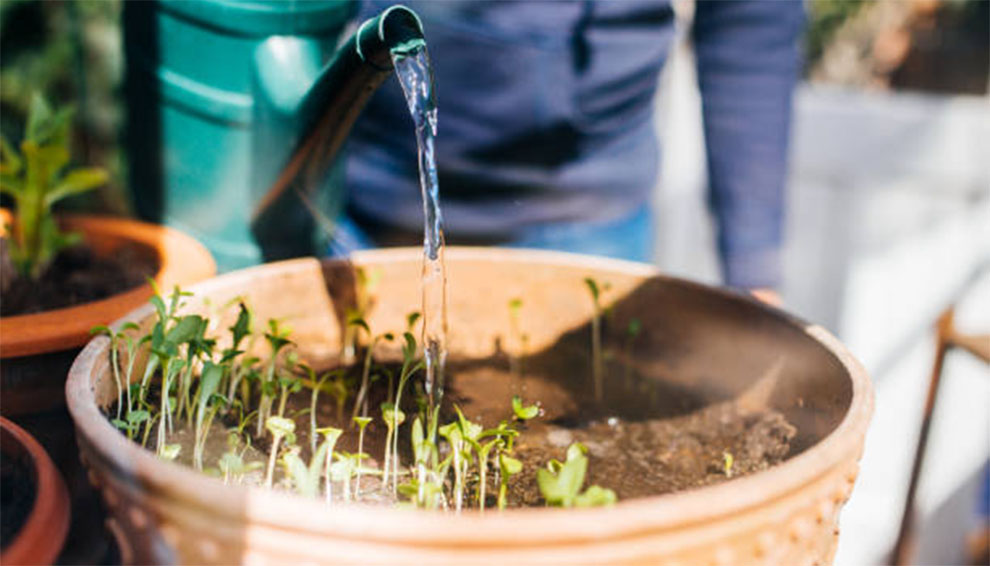
No, self-watering pots do not need rocks at the bottom because these may intervene with its capillary function.
Do Self Watering Pots Need Drainage?
Drainage holes at the pots’ bottom ensure the moisture wicks water into the soil. You do not water the plants from the top in self watering pots. Hence, they must have drainage holes to drain excess water from the soil and maintain necessary moisture levels.
Which Plants Should Never Be Planted In A Self Watering Pot?
Some plants, like cactus or succulents, have a shallow root system. Hence, they will not benefit from a self-watering planter because their roots do not extend far enough to make the most of the pot’s capillary action. Also indoor water plants cannot be placed in self watering planters.
Can You Convert Any Regular Pot Into A Self Watering Planter?
Often people fail to find their desired design or style in the self-watering pots. Hence, some people consider converting their regular pots into self-watering planters. There are two ways to do it. Below we will address it:
A. Using a Conversion Kit
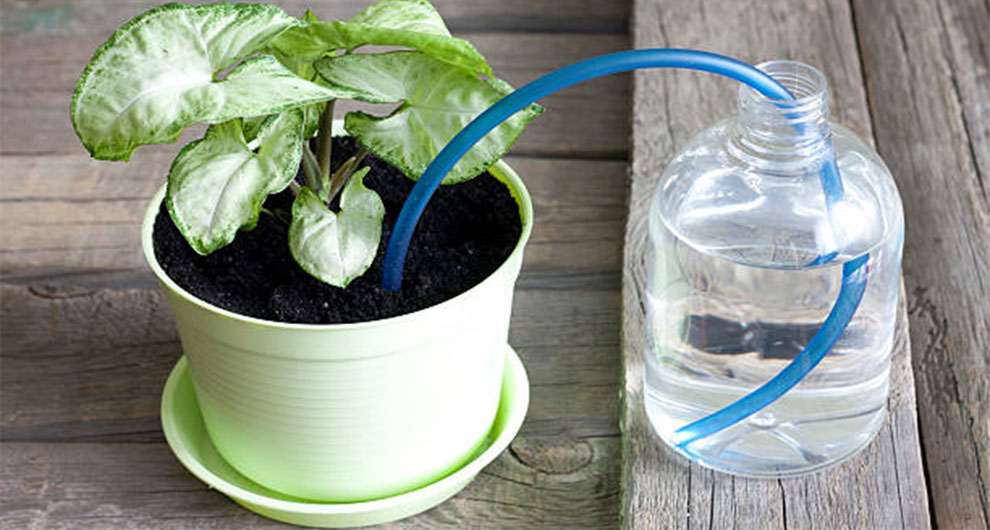
Self-watering inserts simplify the method of creating any regular pot into a self watering container. They have a pre-made structure available. So, all you have to do is insert it and place it at any planter’s bottom.
Once done, you can put potting soil and water into it. Typically, these conversion kits are disc-shaped water reservoirs. They have a water level indicator and a PVC pipe annexed. You can use this pipe to pour water and liquid fertilizer as required.
B. DIY planters
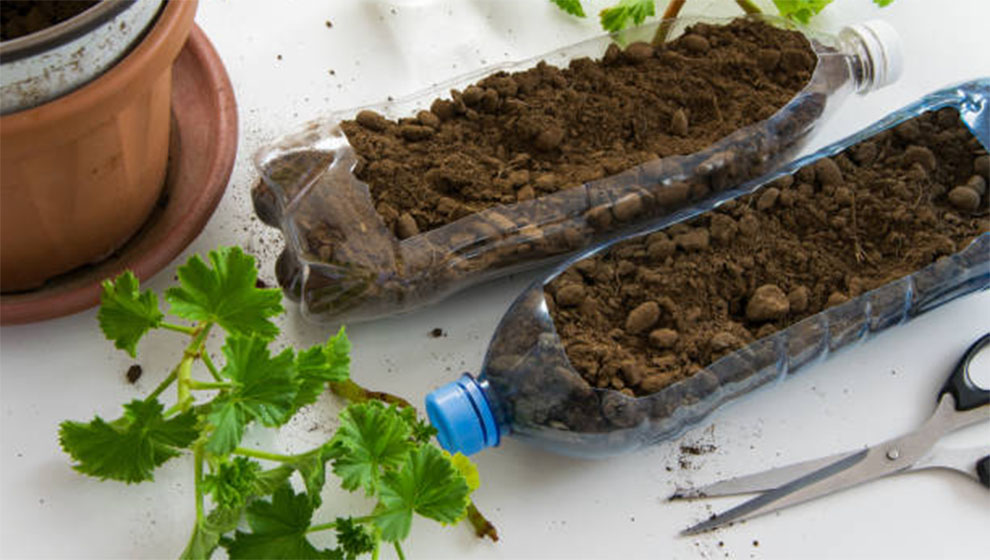
Alternatively, you can also create your own self watering system. For this, you will need the following:
- String or a wicking material
- Narrow tubes
- Planter or Pot
- Small basket or a pot with holes
- Pot
- Container to fit at the pot’s bottom
- Wicking material like string
- Landscape fabric, coffee filter, or mesh to cover the pipe
- Drill
How to create it?
Ever wondered how do self watering planters work, well, here is how you could create one for yourself.
Step 1 – Make the water reservoir
Firstly, you need to build the reservoir that goes inside the planter. So, carve a small hole into the reservoir, ensuring that you can fit it in a pot or a small basket. This basket works like a soil foot or the access point for the soil to draw water from the water chamber. Put this at the planter’s bottom.
Step 2 – Insert a watering tube into it
Insert the tube, ensuring it goes from the water compartment and lands over the soil. It lets you add water to the chamber as required. Conceal pipe both ends with a mesh to ensure that only water can easily pass through the pipe.
Step 3 – Drill overflow holes
Start drilling the drainage holes on either side of the planter. It should be the same height as the watering section. It ensures that the extra water flows off the chamber and does not soak the soil inside the pot.
Step 4 – Add damp soil inside the foot
Put the wicking material into the foot, ensuring it goes from the soil to the water part. Next, fill the foot with damp soil but pack it tightly. Now, fill the remaining space with a good potting mix. However, do not pack it too tight because that contracts the air pockets.
Step 5 – Insert the plant
Lastly, carefully put the plant into the soil and water it from the top. Keep watering for a week or two, giving the plant ample time to adapt to the self-watering planter. After this, ensure that the water reservoir is continually topped up.
Related: Best Compost Tea Brewers
Frequently Asked Questions
Ques 1. How often do you put water in a self-watering planter?
Ans. The planter’s refilling frequency is determined by the type of plant you have and the water reservoir section’s size. Ideally, these planters come with an indicator, as to when they need a refill.
You must also monitor how much water the plant wicks up through the roots. It will help you notice that some plants are more water-thirsty than others. Ideally, an average-sized self-watering plant may demand refilling once a week.
Ques 2. How long does self-watering planter last?
Ans. Typically, the duration you can go without replenishing depends on the reservoir’s size, but in most cases, you will have to refill after two to four weeks max.
Ques 3. Should self-watering pots always have water?
Ans. Yes, self-watering pots must always have water.
Ques 4. Do self-watering pots prevent overwatering?
Ans. Self watering pots can help avoid overwatering because they are enclosed, and the plants will not overwater themselves.
Final Word – How Well Do Self Watering Planters Work?
Above, we have discussed how do self watering containers work and their pros and cons. So, weighing the benefits and the lows, we can say that they are a convenient option, especially for people who regularly struggle with maintaining their plant’s watering schedule or travel often.
They are suitable for almost every plant species and are straightforward. But, they will be costlier than the regular pots. But, if you think they work well for your plants, it can be a worthy investment.

